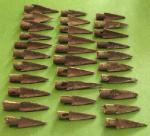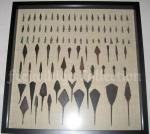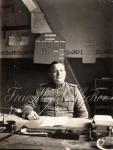-
Posts
621 -
Joined
-
Last visited
-
Days Won
1
Content Type
Profiles
Forums
Blogs
Gallery
Events
Store
Everything posted by Freiwillige
-
Dear gentlemen, I'm currently in the process of writing series of articles on Stahlhelmbund, and I'm looking for your kind assistance in acquiring the following info. 1. Complete list of Sta-Landesverbände 2. Exact dates & venues of all the Frontline Soldiers' Day Here's what i managed to compile from commemorative badges and postcards: - 5.Frontsoldatentag xxxxxxxxxx 1924 Dessau (?) - 6.Frontsoldatentag 18.Januar 1925 Magdeburg - 8.Reichs-Frontsoldaten-Tag 7.- 8. Mai 1927 Berlin - 9.Reichs-Frontsoldaten-Tag xxxxxxxxxx 1928 Hamburg - 10.Reichs-Frontsoldaten-Tag 1.-2.Juni 1929 München - 11.Reichs-Frontsoldaten-Tag 4.-5.Oktober 1930 Koblenz - 12.Reichs-Frontsoldaten-Tag 30.-31.Mai 1931 Breslau - 13.Reichs-Frontsoldaten-Tag 2.-4.September 1932 Berlin - 14.Reichs-Frontsoldaten-Tag 23.-24.September 1933 Hannover /the last one-?/ And one more question, quite general one, on the structure of the Stahlhelmbund: Is it true that after the Dessau Frontsolatentag 1924 Stahlhelmbund was divided into Kernstahlhelm (WW1 veterans with combat experience) and Ringstahlhelm comprising of Landsturm des Stahlhelms and Jungstahlhelm? Does it mean that in post 1924-era Jungstahlhelm never existed as a separate division of Stahlhelmbund, but just as a part of Ringstahlhelm? If so, why Jungstahlhelm continued to use its own insignia rather than embrace that of Ringstahlhelm? Before starting research I really thought that after 1924 Stahlhelmbund consisted of: - Kernstahlhelm, i.e. "original" members with WW1 combat experience; - Ringstahlhelm, i.e. former Landsturm des Stahlhelms ("new" members above 25 years without any combat experience); - Jungstahlhelm, i.e. German youth from 17 to 24 years old. Could you please explain that tricky issue to me? Thanks in advance!
-
Could you please let me know what was the official name of the cross commonly known as “LDA1” upon its institution on July 04, 1868 - “Landwehr-Dienstauszeichnung 1.Klasse” or something like “Landwehr-Dienstauszeichnung für Offiziere”? I’m also totally confused with the award criteria for Landwehr-Dienstauszeichnung 2.Klasse-medal (04.07.1913-01.02.1920), and Landwehr-Dienstauszeichnung 1.Klasse-cross (04.07.1868-01.02.1920). Is it correct that: - LDA1 was awarded for 20 years of impeccable service in the Landwehr / Seewehr to officers, medical officers, NCOs and other ranks (i.e. not only officers) who participated in a campaign, or as an exceptional reward for those who spent a total of three months on active conscripted service without leave? - LDA2 (medal) was awarded to Landwehr/Reserve members who served at least 12 years, and (a) either participated in a campaign or (b) for at least 3 months of full active service. Info posted at various e-sources seems to be contradictory...
-
Dear Gentlemen, could you please help me in clarifying a tricky issue concerning Prussian Landwehr-Dienstauszeichnungen? Having completed series of articles dedicated to regular Prussian army Long Service awards (1825/1913), I'm currently in a process of writing an article on Landwehr awards but I'm a bit confused having compiled available info from various sources. 1. What was the exact name of the Landwehr-Dienstauszeichnungen (Schnalle) when it was instituted by Friedrich Wilhelm IV on January 16, 1842? It's commonly known nowadays as LDA2 (Landwehr-Dienstauszeichnungen 2.Klasse), but there was no 1st Class in 1842 as the latter was introduced on July 04, 1868 only!!! So the questions are: - what was the name of that clasp in 1842-1868, i.e. how was it oficially named in its 1842 Statute? - was it reserved for enlisted ranks and NCOs only in 1842-1868? - was there any AKO or any other Order renaming that clasp as "2.Klasse" when LDA1 for officers was instituted in 1868? 2. Landwehr-Dienstauszeichnungen 1.Klasse was instituted on July 04, 1868 by the King Wilhelm I. What award long serving Prussian Landwehr officers were decorated with before 1868? LDA2 (Schnalle) or no award at all? Many thanks for your help in advance!
-

New Schutzdivision Photo
Freiwillige replied to dante's topic in Germany: Weimar Republic & Deutsche Freikorps
-

What awards did Herman Goering receive?
Freiwillige replied to hhbooker2's topic in State, Civil Awards & Decorations
Speaking of an Order of Saint Tamara it must be noted that there were four different decorations: 1. “Original” decoration - Badge of the Georgian Legion (Abzeichen der Georgischen Legion), 1st and 2nd classes issued in 1917 ex parte the Committee of Independent Georgia. 2. An Order of Saint Tamara, illegitimately established in 1918 by Zakhari Mdivani, the then War Minister of Democratic Republic of Georgia. 3. An Order of Saint Tamara, restored in 1922 by the Parity Committee. 4. An Order of Saint Tamara, restored in 1941 by Shalva Maglakelidze, the future commander of the Georgian Legion. It seems Göring was photographed wearing “M1922” Order that was restored by the Parity Committee, or “Committee for Independence of Georgia” commonly known then as “Damkom” (short for Damoukideblobis Komiteti). Decoration of those who could assist in revival of national, i.e. Georgian awareness was considered an effective measure of a newly formed organization and widely known Order of St.Tamara had been chosen as an official award of the Parity Committee in 1922. Thus the Parity Committee had a right to issue its badges legally, and if so, Göring had a right to wear it legally. -
Dear Rick, I'm really sorry watermark I applied on a CDV did "ruin" an image, even though I've posted two separate fragments with awards without any logo. My request actually was to provide, if possible, full name, complete awards list and positions of Oberst Wechmar, commander of the 1st Brigade of the Baden Division from the Prussian XIV Corps. Hopefully these better scans will help to acquire the info I asked for
-
Here's one the latest additions to my photo collection - faded a bit but still beatiful and rare portrait of a Baden Oberst von Wechmar with a huge medal bar comprising of RAO3X with bow, Baden officers DA, etc. CDV is dated November 06, 1870 on its reverse (it was my mistake while naming a thread)) The most interesting part is an Imperial and Tsarist Order of Saint Stanislaus 2nd Class with crown (!) According to the Statute of that decoration, prior to February 17, 1874 it could have been awarded either with an Imperial crown as an enhanced grade or without such. However, holders of Orders with crown were allowed to wear their awards even after the Royal Decree abolished additional decoration. Is it possible to acquire additional information on that officer, i.e. his full name, complete awards list, positions, etc.? All I managed to find out is that Oberst von Wechmar was a commander of the 1st Brigade (that comprised of the 1st (Baden)(Leib) Grenadier Regiment and the 2nd (Baden) Grenadier Regiment) of the Baden Division under Generalleutenant von Glumer. /Source: Prussian XIV Corps, 19 January 1871/
-

Framed archeological finds
Freiwillige replied to Freiwillige's topic in Non Military Collectibles & Antiques
Many thanks, Mervyn! I've got more frames - axes, crosses, etc... -

Framed archeological finds
Freiwillige replied to Freiwillige's topic in Non Military Collectibles & Antiques
Photo No.3. Here's another frame from solid wood with some nice items: - The so-called "whistling arrowhead" dating back to the end of XIII-first quarter of XIV centuries. It originates from one of the Old Russian settlements. - The spearhead that belonged to the Alans, a group of Sarmatian nomadic tribes. This one is dated V-VIII centuries A.D. - Genovese spearhead, also from V-VIII centuries A.D. Hope you like it! -

Framed archeological finds
Freiwillige replied to Freiwillige's topic in Non Military Collectibles & Antiques
-

Framed archeological finds
Freiwillige replied to Freiwillige's topic in Non Military Collectibles & Antiques
Another "interim shot") The small arrow with a hook is a Greek one (IV-III centuries B.C.), five arrow heads at the right side as well as the left one ot the bottom belonged to the Alans. The rest were used by Tartars and Khazars. -

Framed archeological finds
Freiwillige replied to Freiwillige's topic in Non Military Collectibles & Antiques
Thanks, Mervyn! Well, most of the arrow heads as well as other archeological finds are well researched. Let's take these, for example (photo was made before mounting). The two at the upper right are dated IV or III centuries A.D. and belonged to the Alans, a group of Sarmatian nomadic tribes. Scythians were equipped with the four at the very bottom (IV-III centuries B.C.) The rest mainly belonged to Khazars, Tartars and Slavs (VIII-XIII centuries A.D.). The ones used by Tatars have distinctive ring between edge and heft. -

Framed archeological finds
Freiwillige replied to Freiwillige's topic in Non Military Collectibles & Antiques
Thanks, Sam! With the lapse of time collecting of militaria items only turns out to be a bit monotonous and a slight distraction seems to be indispensable, at least for me P.S. I have more frames with various ancient items and will post them here if they are of any interest to the community) -

Framed archeological finds
Freiwillige replied to Freiwillige's topic in Non Military Collectibles & Antiques
Photo No.2. Framed antique rings and signets that belonged to men and ladies, merchants and warriors. Most remarkable pieces are two in the middle with large swastikas that are dated IX century A.D. -
Dear gentlemen and ladies, archeological finds being one of my side interests, I'd like to share with you several photos of frames from my collection. They look really nice as walls decorations as I can't put photos and documents on display))) Photo No.1. Framed arrows dating back from IV century B.C. to XIII century A.D. Various epochs, countries and peoples...
-
Dear gentlemen, could you please help me with obtaining any additional information on the following DKiG and Ehrenpokal holder: Leutnant Erwin Kretschmer (20.11.1920, Niemes - 26.09.1942, Woronesch, USSR), 7./Stuka-Geschwader 2. A friend of mine managed to buy an Ehrenpokal issued to Lt.E.Kretschmer and is trying to research on personality of the holder. Many thanks in advance!
-
Dear gentlemen, I managed to acquire this portrait recently. I assume he's a Polizei-Major from one of the Weimar-era German states. Could you please help me with identifying the branch of service he belonged? I've never seen such a Gothic "S" insignia on collar tabs before. Please note there's some obscure device on his shoulder boards as well, but I don't think it's a pip for an Oberstleutnant, rather another "S"?















